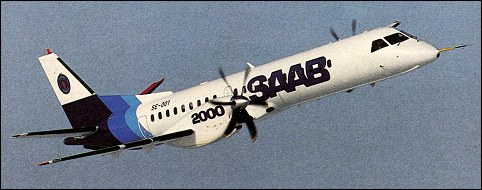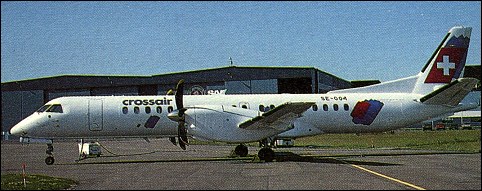 |
Saab 20001992 |  |
| PASSENGER | Virtual Aircraft Museum / Sweden / Saab |
 |
Saab's experience with the S340 commuter airliner turned its attention to the future needs of regional and 'feeder' carriers. While the mainstream airtransport market was an unpredictable one, Saab felt that the need for smaller, flexible turboprops that could match jet performance over a range of sectors was a clearly defined one whose time had come. Having forged a market with its smaller aircraft, Saab used the S340 as a baseline from which to develop a new 50-seat, high-speed turboprop airliner which was to be called the Saab 2000. The go-ahead came with a launch order from Moritz Suter's Crossair, already a firm Saab customer, which signed for 25 aircraft with a further 25 on option, on 15 December 1988. By late 1989 project definition for the Saab 2000 had been completed, with the contracting out of major portions of the aircraft's construction. CASA of Spain was responsible for the wing design and production, though Saab defined the basic airfoil structure. Valmet of Finland was to build the entire tail unit and elevators, while in England, Westland is responsible for the rear fuselage. For the cockpit, a Collins Proline 4 avionics suite was selected, while a radical reduction in cabin noise levels over existing aircraft was also promised. The concept of 'hub bypass' was central to Saab's sales efforts for the aircraft. To achieve this, Saab planned to build an aircraft capable of 665km/h over a 1850km sector, a speed comparable with the BAe 146 (Avro RJ). A jet-like climb performance was also essential, with figures of 0-6096m in less than 11 minutes assured. The original choice of engine fell between General Electric's GE38, then under development for the US Navy's projected LRAACA maritime patrol aircraft, and the Pratt & Whitney PW300 turbofan. In the event, and in conjunction with Crossair, Saab opted for the Allison GMA 2100 turboprop, driving six-bladed, low-noise Dowty propellers. As part of the deal Allison was contracted to build the engine nacelles. First metal was cut at Linkoping in February 1990, and the prototype's (SE-001) maiden flight occurred on 26 March 1992. A four-aircraft test programme was established with aircraft No. 2 (SE-002) involved in stability and control certification. Much of the high-temperature and adverse weather flying was undertaken by the No. 2 Saab 2000, which completed two visits to Spain. The first full production-standard aircraft was SE-003, with which all the systems certification was achieved, only the autopilot certification being outstanding in mid-1993. Functional reliability flights were undertaken by aircraft No.4 (SE-004), as part of the ongoing test programme which has so far exceeded 1,200 hours across the fleet. All Saab's performance guarantees have been met or exceeded. Take-off and landing distances were bettered by 100-200m. Time from brake release to 6096m is less than eight minutes, and in proving this the Saab 2000 easily broke the existing time-to-climb record for an aircraft in its class (previously held by a Grumman E-2 at 10 minutes). Range and weights have all been better than expected on the production standard aircraft, and the promised cruise speed of 665km/h at 8534m is, on average, 15km/h better. In a dive the Saab 2000 has reached 794km/h with no ill effects. International noise requirements have been bettered by 9.1 decibels. Reducing cabin noise was a cornerstone of the Saab 2000 design philosophy and Saab has developed a so-far unique anti-noise system that has been test flown on a Saab 340, ready for inclusion on its larger sibling. This involves a series of microphones, located around the interior, which monitor cabin noise and then re-broadcast an equal opposite; wave, thus effectively 'switching off' background noise and vibration. Saab originally foresaw a market for 1,400 new 40- to 50-seat regional airliners by the end of the century, and sales of 400 Saab 2000s were anticipated. While the manufacturer holds well over 100 paid options, only; 36 firm orders had been received by July 1993. First delivery, to Crossair, is scheduled for the fourth quarter of 1993, while the seventh aircraft and the first for Deutsche BA (formerly Delta Air) flew on 24 June 1993.
|  COMPANY PROFILE | ||||||||||||||||||||||||||||||||||||||||||||||||||||||
 |

|

 Pablo
Pablo
20
reply